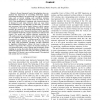Free Online Productivity Tools
i2Speak
i2Symbol
i2OCR
iTex2Img
iWeb2Print
iWeb2Shot
i2Type
iPdf2Split
iPdf2Merge
i2Bopomofo
i2Arabic
i2Style
i2Image
i2PDF
iLatex2Rtf
Sci2ools
ICRA
2009
IEEE
2009
IEEE
Exploiting angular momentum to enhance bipedal center-of-mass control
Abstract— Recent humanoid control investigations have emphasized the importance of controlling whole-body angular momentum throughout a movement task. For typical movement tasks, such as normal walking, such controllers minimize fluctuations in angular momentum about the center of mass (CM). This minimization is consistent with observed behavior of humans for such tasks. However, there are cases where such minimization is not desirable. In this study, we investigate movement tasks where bipedal balance control requires a relaxation of the goal of minimizing whole-body angular moment. We construct a humanoid model having a human-like mass distribution, and a Moment-Exploiting Control algorithm that modulates whole-body angular momentum to enhance CM control. The model only requires reference trajectories for CM position and torso orientation. Joint reference trajectories are not required. While balancing on one leg, we show that the controller is capable of correcting errors in CM st...
| Added | 23 May 2010 |
| Updated | 23 May 2010 |
| Type | Conference |
| Year | 2009 |
| Where | ICRA |
| Authors | Andreas Hofmann, Marko B. Popovic, Hugh M. Herr |
Comments (0)

